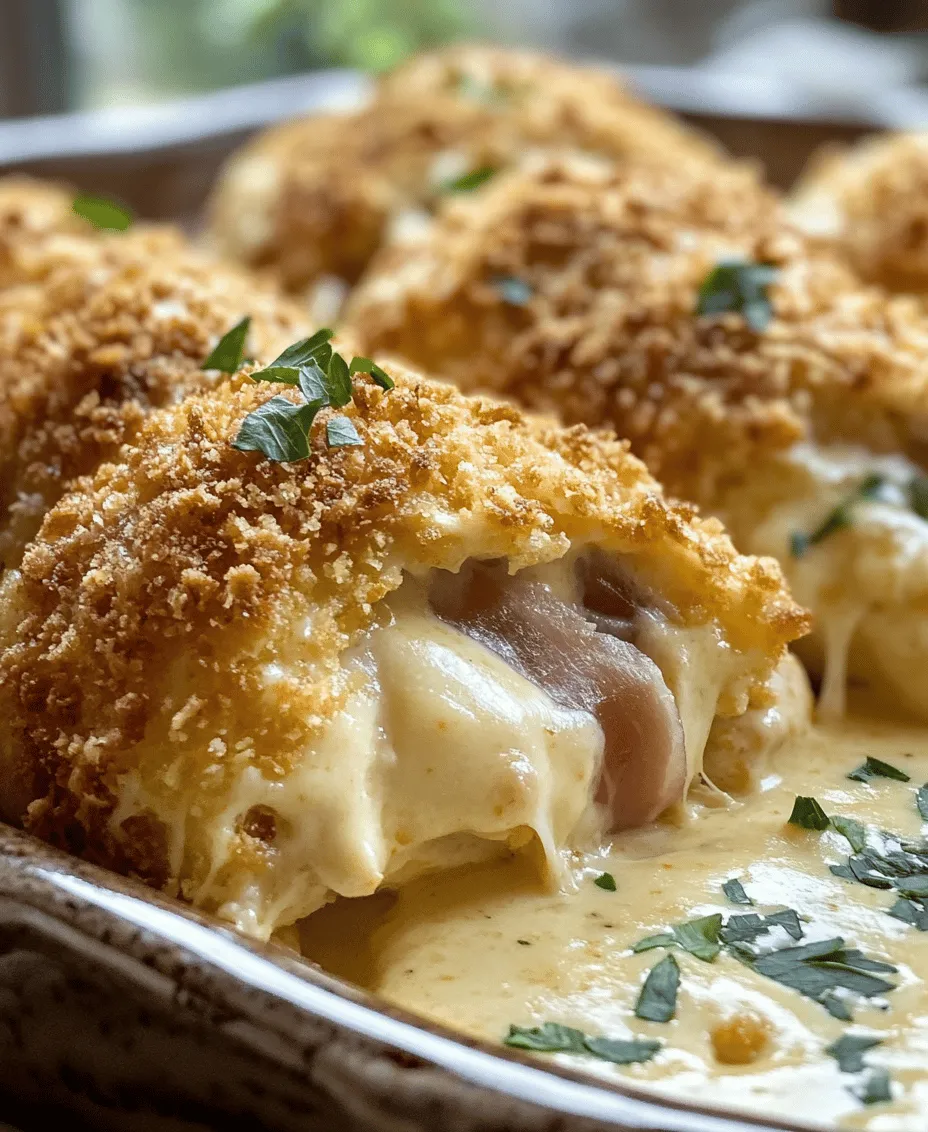Introduction
Chicken Cordon Bleu is a beloved classic that beautifully combines tender chicken, savory ham, and gooey cheese into a culinary masterpiece. With its crispy exterior and succulent interior, this dish has won the hearts of home cooks and restaurant-goers alike. The allure of Chicken Cordon Bleu lies not only in its rich flavors but also in its versatility; it can grace the dinner table for both casual family meals and festive occasions.
What makes this recipe even more enticing is the addition of a creamy Swiss cheese sauce that elevates the dish to new heights. This sauce adds a luxurious touch, enhancing the overall flavor profile and bringing together the elements of the dish in a delightful way. Whether you’re aiming to impress guests or indulge in a comforting meal at home, this Chicken Cordon Bleu recipe promises to deliver satisfaction and joy.
In this article, we will provide you with step-by-step guidance on how to create this delectable dish from start to finish. So, roll up your sleeves and get ready to embark on a culinary adventure that will leave your kitchen filled with enticing aromas and your palate craving more.
The History of Chicken Cordon Bleu
The origins of Chicken Cordon Bleu are somewhat murky, but it is widely believed that the dish hails from Switzerland, where it was known as “Cordon Bleu.” This term translates to “blue ribbon,” a symbol of excellence and high culinary standards. The dish originally featured veal or pork, but over time, chicken became the preferred protein due to its widespread popularity and accessibility.
As Chicken Cordon Bleu made its way across borders, it underwent various adaptations influenced by regional tastes and available ingredients. For instance, in France, the traditional preparation includes a breaded and fried cutlet stuffed with ham and cheese, while in the United States, the dish has gained fame as a baked version that is often smothered in creamy sauces.
The versatility of Chicken Cordon Bleu has contributed to its global appeal. Today, you can find numerous variations of the dish, including those that substitute chicken with turkey or even vegetarian options that use eggplant or tofu. Despite these adaptations, the core essence of the dish remains the same: a delicious combination of meat, cheese, and a crispy outer layer.
Understanding the Ingredients
Crafting the perfect Chicken Cordon Bleu begins with understanding the essential ingredients that contribute to its flavor and texture. Each component plays a vital role in creating a harmonious dish that delights the senses.
Chicken Breasts
At the heart of Chicken Cordon Bleu are the chicken breasts, which serve as the primary protein. When selecting chicken breasts, it’s important to choose boneless and skinless cuts for ease of preparation. The chicken should be pounded to an even thickness, which ensures uniform cooking and helps the meat stay tender and juicy.
Ham Choice
The type of ham used in Chicken Cordon Bleu can significantly impact the dish’s flavor. While traditional recipes often call for thinly sliced Swiss ham, you might also consider using prosciutto for a more gourmet touch. Prosciutto adds a delicate sweetness and a hint of saltiness that pairs beautifully with the rich cheese. If you’re looking for a more budget-friendly option, regular deli ham works just as well; the key is to select a high-quality product that complements the other ingredients.
Swiss Cheese
Swiss cheese is a quintessential component of Chicken Cordon Bleu, providing a creamy and nutty flavor that melds perfectly with the ham. Its excellent melting properties make it an ideal choice for stuffing, creating that signature gooey texture that diners crave. Other cheese varieties, such as Gruyère or Emmental, can also be used for a twist on the classic recipe, adding different flavor notes and textures.
Breadcrumbs
To achieve the signature crispy coating of Chicken Cordon Bleu, breadcrumbs are essential. Panko breadcrumbs are often preferred for their light and airy texture, which creates a delightful crunch when baked or fried. However, traditional breadcrumbs can also be used; just ensure they are seasoned appropriately to enhance the overall flavor of the dish.
Creamy Swiss Cheese Sauce Components
The creamy Swiss cheese sauce is the crowning glory of this recipe, adding richness and depth to the dish. The sauce typically includes heavy cream, chicken broth, and Dijon mustard, each contributing to a luxurious texture and robust flavor.
– Heavy Cream: This ingredient provides the sauce’s creamy consistency and rich mouthfeel. It helps balance the saltiness of the cheese and ham, creating a harmonious blend of flavors.
– Chicken Broth: Adding chicken broth enhances the sauce’s overall depth and ties the flavors together. Opt for low-sodium broth to control the saltiness of the dish.
– Dijon Mustard: A touch of Dijon mustard elevates the flavor profile of the sauce, adding a zing that cuts through the richness and brings the whole dish to life.
With a clear understanding of these key ingredients, you are well on your way to crafting a Chicken Cordon Bleu that is not only delicious but also reflective of the classic dish’s roots and variations.
Step-by-Step Preparation Process
Now that you’re familiar with the history and ingredients of Chicken Cordon Bleu, it’s time to dive into the preparation process. Follow these step-by-step instructions to create a dish that will impress your family and friends.
Prepping the Chicken
The first step in preparing Chicken Cordon Bleu is to properly prep the chicken breasts. This ensures that they cook evenly and remain tender.
1. Pound the Chicken: Place a chicken breast between two sheets of plastic wrap or parchment paper. Using a meat mallet or rolling pin, gently pound the chicken to an even thickness of about 1/2 inch. This step is crucial, as it ensures that the chicken cooks evenly and remains juicy.
2. Season the Chicken: Once the chicken is pounded, season both sides generously with salt and pepper. Proper seasoning is essential, as it enhances the flavor of the chicken and the overall dish.
3. Repeat for Remaining Breasts: Continue this process with the remaining chicken breasts, ensuring that each piece is evenly pounded and seasoned.
Assembling the Cordon Bleu
With your chicken prepped, it’s time to assemble the Chicken Cordon Bleu. This step involves layering the ham and cheese, followed by rolling the chicken to secure the filling.
1. Layer the Ham and Cheese: Place a slice of ham on each chicken breast, followed by a slice of Swiss cheese. Ensure that the ham and cheese cover most of the chicken, leaving a small border around the edges to prevent spilling during cooking.
2. Roll the Chicken: Starting from one end, carefully roll the chicken breast tightly around the filling. Tuck in the sides as you roll to keep the ham and cheese from escaping.
3. Secure the Roll: Once rolled, secure the chicken with toothpicks or kitchen twine to hold its shape during cooking. This step is important to ensure that the filling stays intact, resulting in a beautiful presentation when served.
With the chicken rolled and secured, you’re ready to move on to the next stages of cooking, which will transform these components into a delectable Chicken Cordon Bleu with a creamy Swiss cheese sauce. Stay tuned for the next section, where we will detail the cooking methods and serve suggestions that will take your dish to the next level.

Breading Techniques for Crispy Coating
Achieving a crispy and golden coating on your Chicken Cordon Bleu is essential for both flavor and texture. The right breading technique is key to ensuring your dish stands out. Here’s how to set up a breading station and execute the breading process seamlessly.
Setting Up a Breading Station
Before you begin breading your chicken, it’s crucial to organize your workspace. A well-structured breading station can streamline the process and minimize mess.
1. Gather Your Supplies: You will need three shallow dishes: one for all-purpose flour, another for beaten eggs, and the last for breadcrumbs. Additionally, have your seasoned breadcrumbs ready, which can be made from store-bought or homemade bread.
2. Seasoning the Flour: Enhance the flavor of your breading by seasoning the flour with salt, pepper, and optional spices such as garlic powder or paprika. This base layer of flavor will ensure that every bite is delicious.
3. Order of Operations: Arrange your dishes in the following order: flour, egg, and breadcrumbs. This setup will help you coat your chicken in a systematic manner and avoid cross-contamination.
Detailed Steps for Each Stage of Breading
1. Dredging in Flour: Start by taking your chicken breast and gently coat it in the seasoned flour. This layer helps the egg wash adhere better and adds flavor.
2. Dipping in Egg: Next, dip the floured chicken into the beaten eggs. Ensure it’s fully coated; this will act as a glue for your breadcrumbs.
3. Coating in Breadcrumbs: Finally, press the chicken into the breadcrumbs, ensuring an even coating. Press down slightly to help the breadcrumbs stick well. The more evenly coated your chicken, the crispier it will become during cooking.
The result of these techniques is a beautifully crispy coating that locks in moisture and enhances the overall flavor.
Cooking Methods: Frying and Baking
Two primary cooking methods can be used to achieve a perfect Chicken Cordon Bleu: frying and baking. Each method has its benefits that contribute to the dish’s overall appeal.
Explanation of Frying to Achieve Golden Brown Perfection
Frying is a traditional method that can give your chicken an irresistible crunch. Here’s how to fry effectively:
1. Heat the Oil: In a large skillet, pour enough vegetable oil to cover the bottom of the pan (about 1/4 inch deep). Heat the oil over medium heat until it shimmers – this indicates that it’s hot enough for frying.
2. Fry the Chicken: Carefully place the breaded chicken in the hot oil. Fry for about 4-5 minutes per side, or until golden brown and cooked through. Use a meat thermometer to ensure the internal temperature reaches 165°F (75°C).
3. Drain Excess Oil: Once cooked, transfer the chicken to a paper towel-lined plate to absorb excess oil. This step is crucial to maintain the crispiness of your Cordon Bleu.
Transitioning from Skillet to Oven
While frying gives you that golden crust, finishing your Chicken Cordon Bleu in the oven enhances the flavors and ensures thorough cooking. Here’s how to transition:
1. Preheat Your Oven: Before frying, preheat your oven to 350°F (175°C).
2. Transfer to Baking Dish: After frying, place the chicken in a baking dish. This prevents the crust from becoming soggy during the baking process.
3. Bake for Flavor and Texture: Bake for an additional 10-15 minutes. This step helps melt the cheese inside without overcooking the chicken, resulting in a juicy, flavorful dish.
Crafting the Creamy Swiss Cheese Sauce
A creamy Swiss cheese sauce is the perfect accompaniment for your Chicken Cordon Bleu. Here’s how to make it step-by-step.
Step-by-Step Instructions for Making the Sauce in the Skillet
1. Start with a Roux: In a medium skillet, melt 2 tablespoons of butter over medium heat. Once melted, whisk in 2 tablespoons of all-purpose flour, stirring constantly for about 1-2 minutes until it forms a paste and turns a light golden color.
2. Adding Liquid: Gradually whisk in 1 cup of milk, ensuring there are no lumps. Continue to stir until the sauce thickens, which should take about 3-4 minutes.
3. Incorporate the Cheese: Reduce the heat to low and add 1 cup of shredded Swiss cheese. Stir continuously until the cheese has melted and the sauce is smooth.
Techniques for Incorporating Cheese Smoothly into the Sauce
To achieve a velvety cheese sauce, it’s important to add the cheese gradually. If the cheese is added too quickly or at too high a temperature, it can become grainy. Here are a few tips:
– Shred Your Cheese: Always use freshly shredded cheese instead of pre-shredded, as the latter often contains anti-caking agents that can affect the sauce’s texture.
– Low Heat is Key: Keep the heat on low when adding cheese to avoid overheating and curdling.
Flavor Enhancement Tips Using Dijon Mustard and Seasoning
To elevate the flavor of your sauce, consider adding a teaspoon of Dijon mustard. This will impart a tangy richness that complements the chicken beautifully. Additionally, season with salt, pepper, and a pinch of nutmeg for an extra layer of depth.
Final Steps: Baking and Serving
Once your Chicken Cordon Bleu is cooked and the cheese sauce is ready, it’s time to bring everything together.
Instructions for Baking with Proper Temperature Settings
– Baking Temperature: Ensure your oven is set to 350°F (175°C) for the final baking stage. This temperature allows for even cooking without over-browning the crust.
– Bake Covered or Uncovered: You can choose to cover the chicken with aluminum foil to keep it moist or leave it uncovered to allow the crust to stay crispy.
Importance of Resting Time After Baking for Juiciness
After baking, let the Chicken Cordon Bleu rest for about 5 minutes. This resting period allows the juices to redistribute throughout the chicken, resulting in a moist and tender bite.
Presentation Tips: Garnishing and Serving Suggestions
For an appealing presentation, consider garnishing the dish with freshly chopped parsley or chives. Serve the Chicken Cordon Bleu over a bed of creamy mashed potatoes or alongside a crisp salad. Drizzle the creamy Swiss cheese sauce generously over the top for a visually appealing finish.
Nutritional Benefits of Chicken Cordon Bleu
While Chicken Cordon Bleu is often viewed as a decadent indulgence, it does offer some nutritional benefits that can be appreciated.
Discussion of Nutritional Content of the Dish
– Protein Power: Chicken is an excellent source of lean protein, which is essential for muscle repair and growth.
– Calcium-Rich: The Swiss cheese sauce adds a good dose of calcium, which is important for bone health.
Balancing Indulgence with Nutrition
While this dish is rich and comforting, it’s important to balance indulgence with nutrition. Pairing it with a side of steamed vegetables or a fresh salad can enhance the meal’s nutritional profile while providing a satisfying contrast to the creamy sauce.
Suggestions for Side Dishes to Complement the Meal
– Vegetable Medley: A mix of sautéed seasonal vegetables can add freshness and color to your plate.
– Herbed Rice: Fluffy rice seasoned with herbs can be a delightful base to soak up the creamy sauce.
Variations and Substitutions
To cater to various dietary preferences, there are several ways to adapt the classic Chicken Cordon Bleu recipe.
Ideas for Alternative Ingredients for Dietary Preferences
– Gluten-Free Options: Substitute regular flour and breadcrumbs with gluten-free alternatives. Almond flour or crushed gluten-free crackers work wonderfully as breading.
– Vegetarian Substitutes: For a vegetarian twist, consider using thin slices of eggplant or zucchini in place of chicken. You can also use plant-based cheeses to create a similar flavor profile.
Suggestions for Different Cheeses or Types of Meat
– Cheese Variations: While Swiss cheese is traditional, you can experiment with Gruyère, mozzarella, or even a sharp cheddar for a different flavor.
– Meat Options: Instead of chicken, try turkey cutlets or pork loin for a tasty variation.
Creative Twists on the Classic Recipe for Adventurous Eaters
– Stuffed with Spinach and Feta: For a Mediterranean flair, stuff your chicken with spinach and feta cheese before breading and frying.
– Buffalo Chicken Cordon Bleu: Add some heat by mixing hot sauce into the cream sauce or using spicy cheeses.
Conclusion
Chicken Cordon Bleu with Creamy Swiss Cheese Sauce is a delectable dish that combines tender chicken, savory ham, and rich cheese, all enveloped in a crispy coating. This recipe not only tantalizes the taste buds but also offers a satisfying cooking experience. Whether you are preparing it for a family dinner or a special occasion, this dish is sure to impress.
We encourage you to give this recipe a try, enjoying every step of the cooking process. With its comforting flavors and versatility, Chicken Cordon Bleu has earned its place as a beloved comfort food in many households. Dive into this culinary adventure and discover the joy of creating a classic dish that never goes out of style.



